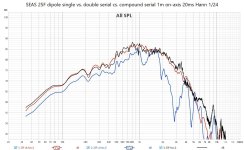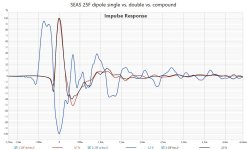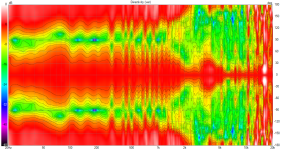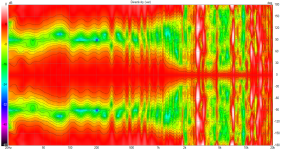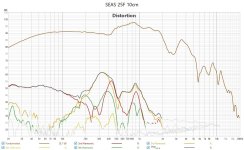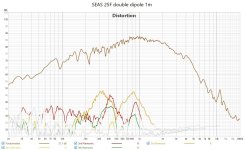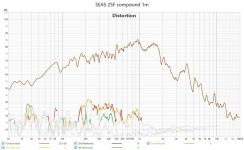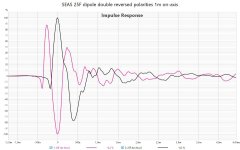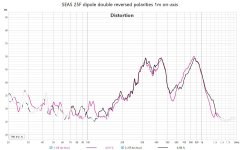A member asked how to wire compound nude dipole woofers. After wiring was solved, vivid discussion about the sanity of compuond (opposed) arrangement benefits.
I happen to to have two SEAS 10" woofers 25F-EWX H108 from 1982, so here are my measurements and pics. I used serial connection for double woofers, naturally with opposed compound, the backside woofer was in inverted polarity. With parallel wiring sensitivity would increase or distortion for same spl would be better.
Test was performed indoors with a woodden ladder frame. the frame and the room both make artefacts in measurements, but they are similar in every series.
I use ODAC, Vincent SV-129 (volume at 9 o'clock) and UMIK-1 mk2 with REW.
Nearfield measurements of a single driver in this post.
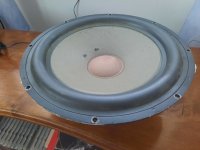
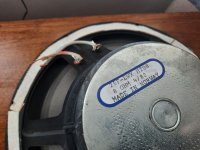
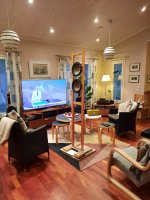
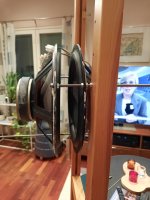
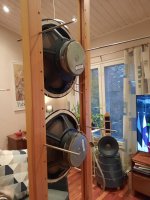
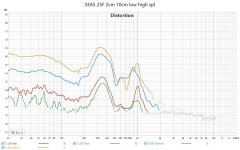
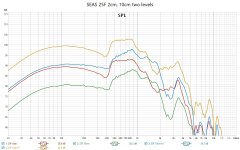
Background
See attached 2 (rather dusty) photos of an old open baffle opposing-driver sub-woofer project, I want to resurrect.
It uses:
Of note, in this kind of speaker, one needs to connect the drivers out-of-phase.
It worked great and matched very...
See attached 2 (rather dusty) photos of an old open baffle opposing-driver sub-woofer project, I want to resurrect.
It uses:
- a pair of 15" PrueAudioProject woofers, which PureAudioProject had Eminence optimize for open baffle.
- spacers to connect the drivers
- wrought iron table legs from which to hang the drivers
- rubber tie downs as the suspension
Of note, in this kind of speaker, one needs to connect the drivers out-of-phase.
It worked great and matched very...
- aagas
- Replies: 59
- Forum: Subwoofers
I happen to to have two SEAS 10" woofers 25F-EWX H108 from 1982, so here are my measurements and pics. I used serial connection for double woofers, naturally with opposed compound, the backside woofer was in inverted polarity. With parallel wiring sensitivity would increase or distortion for same spl would be better.
Test was performed indoors with a woodden ladder frame. the frame and the room both make artefacts in measurements, but they are similar in every series.
I use ODAC, Vincent SV-129 (volume at 9 o'clock) and UMIK-1 mk2 with REW.
Nearfield measurements of a single driver in this post.







Last edited:
Thanks for this!
Just to check, in the graphs in post 2, red is a single nude driver, black is a pair of nude drivers, mounted one above the other, and blue is a pair of nude drivers one behind the other, in 'compound' layout?
(Are you sure you got the polarities correct in the compound connection? The twin peaks in the impulse response should surely both be positive - or both negative - but it looks as if there's a positive peak then a negative one.)
Just to check, in the graphs in post 2, red is a single nude driver, black is a pair of nude drivers, mounted one above the other, and blue is a pair of nude drivers one behind the other, in 'compound' layout?
(Are you sure you got the polarities correct in the compound connection? The twin peaks in the impulse response should surely both be positive - or both negative - but it looks as if there's a positive peak then a negative one.)
Oh, I see what you mean by two peaks - the 'wiggle' in the initial positive impulse creates two peaks. But they are very close in time - maybe 150 microseconds apart? That would fit a 5cm driver spacing. But won't the acoustic centres of the drivers be further apart than that?Compound has two peaks in impulse because of separation distance
I was looking at the big negative peak, centred on zero time. What's that, if it's not the second driver? The centre of the first big peak is roughly about 350 microseconds before the zero point, and the big negative peak is on zero - if that's the two drivers, it would fit with a separation of about 12cm, which looks possible. No? (But, then, what's the wiggle?)
REW sets 0 time at highest amplitude peak automatically. UMIC is usb-mic, no physical reference timing.
The impulse graph in post #1 is actually step response from REW.
The impulse graph in post #1 is actually step response from REW.
Last edited:
This morning I turned the other driver(dsri) and took more measurements.
Double reverse-inverted seems like having lowest distortion below 200hz, but compound shines 200-600Hz
Notice that dsri was not mechanically coupled like cs.
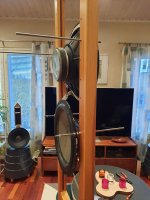
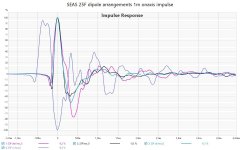
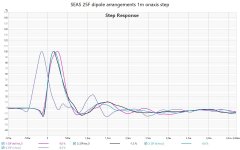
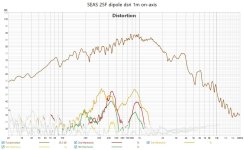
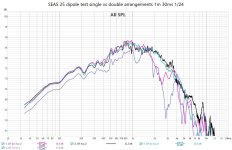


ps. Adjusting distance between compound or reversed doublet drivers would improve impulse (by matching acoustic centers better)
Double reverse-inverted seems like having lowest distortion below 200hz, but compound shines 200-600Hz
Notice that dsri was not mechanically coupled like cs.







ps. Adjusting distance between compound or reversed doublet drivers would improve impulse (by matching acoustic centers better)
Last edited:
Thank you for posting this. Compound subs, or clamshell as some call it, was the basis for my dipole. I was never really sure how to measure the bass the right way. Sadly these are partly dismantled and on the back burner for a while. The bass was one thing I really liked about them. Hit a room mode at 30Hz, but some EQ tamed that and gave very nice results


Thanks for this. You can see the huge increase in LF cancellation. I was wrong, clearly, in post 4 above - you had the polarity correct there. The impulse response of the compound arrangement is really ugly, then - I wonder what's going on? Also, you seem to be losing about 3 dB(?) compared with the other connections.Just for fun I miswired the reversed doublet
I wonder if the ugliness in the compound pair's impulse response could be reflections - the output of one cone bouncing off the other? That might be showing up in the FR graph too, the dip just above 1kHz, and/or the bigger dip at nearly 3 kHz. Maybe those are just effects of the different arrival times, though.
Anyway, these dips are well above the passband you'd be wanting to use with compound nude woofers. More concerning is the loss of output, which affects the bass range. Maybe a larger gap between the drivers would alter this?
Anyway, these dips are well above the passband you'd be wanting to use with compound nude woofers. More concerning is the loss of output, which affects the bass range. Maybe a larger gap between the drivers would alter this?
Reference timing in REW must be corrected for 90deg spl (or even near that depending of room) because of nulling makes direct response impulse very low.
I will try different inter-distance for reversed doublet today, trying to match acoustic centers. But I have no interest to play with compound doubled.
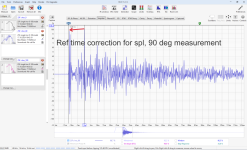
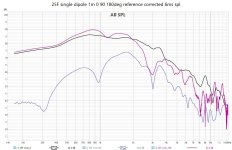
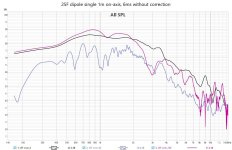
I will try different inter-distance for reversed doublet today, trying to match acoustic centers. But I have no interest to play with compound doubled.



By adjusting distance between woofers acoustic centers matching can be adjusted. In my test upper reversed driver was shifted, positive value means that the reversed driver ws moved closer to mic, see pics. Negative distance difference was used in yesterday's tests, drivers attached to the pole from different sides. Drivers were not well mechanically coupled together in this test, whch can be the reason for high distortion between 300-900Hz
Time alignment affects spl response here only above 2kHz, which is irrelevant for woofers. Distortion doesn't change. Impulse and step response will change - sharp peak with minimal ringing indicates good alignment, For comparison a single driver's measurement is included.
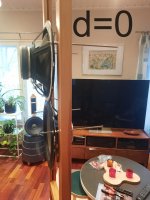
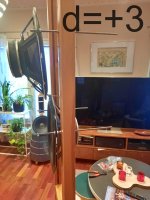
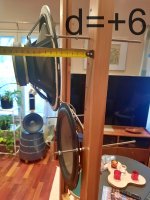
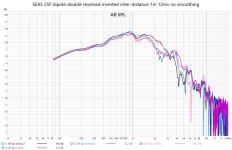
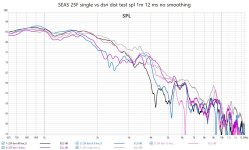
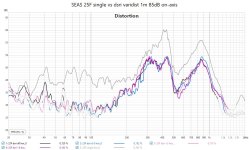
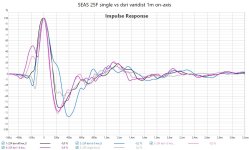
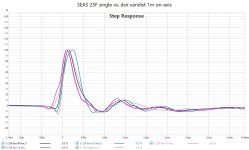
Time alignment affects spl response here only above 2kHz, which is irrelevant for woofers. Distortion doesn't change. Impulse and step response will change - sharp peak with minimal ringing indicates good alignment, For comparison a single driver's measurement is included.








Last edited:
Juha,
If I am understanding the graphs correctly, then a second woofer reversed, and signal inverted so the cones move in phase acoustically, leads to lower distortion in the bass?
I’m glad to see this measured finally. For many years it made me curious when various implementations of push-pull woofers were on the market. But I could never find any measurements to back up statements that the even order distortion was reduced. Eg. M&K push pull subwoofers, Alison Acoustics push-pull woofers in their 3 ways.
If I am understanding the graphs correctly, then a second woofer reversed, and signal inverted so the cones move in phase acoustically, leads to lower distortion in the bass?
I’m glad to see this measured finally. For many years it made me curious when various implementations of push-pull woofers were on the market. But I could never find any measurements to back up statements that the even order distortion was reduced. Eg. M&K push pull subwoofers, Alison Acoustics push-pull woofers in their 3 ways.
Yes, but doubling driver count will always reduce distortion. In my teast driver fixation to the pole varies, these results show only small differences between doublets. Doubles were electrically serially wired, each driver 8R. Parallel wiring might give a bit better distortion%, but I have now dismantled the setup.
Opposed orientation will neutralize T/S and acoustic asymmetries, theoretically reducing nonlinear behaviour (distortion), but major benefit comes from doubling cone area and motor force.
Here THD % closer look
25F is single
ds is double with cones toward the mic
cs is compound with motor toward the mic (other driver in inverted polarity)
dsri is double with one cone, the other motor toward the mic (other driver in inverted polarity) (see photos in earlier posts)
So, the compound arrangement (gives minimal benefit, double side-by side with other driver reversed and inverted is best!

Opposed orientation will neutralize T/S and acoustic asymmetries, theoretically reducing nonlinear behaviour (distortion), but major benefit comes from doubling cone area and motor force.
Here THD % closer look
25F is single
ds is double with cones toward the mic
cs is compound with motor toward the mic (other driver in inverted polarity)
dsri is double with one cone, the other motor toward the mic (other driver in inverted polarity) (see photos in earlier posts)
So, the compound arrangement (gives minimal benefit, double side-by side with other driver reversed and inverted is best!
Last edited:
Monte Kay did this dsri style config with just 8 15" woofers:

"...The SPL meter was reading 103 dB for this measurement. "

Reference:
https://www.mfk-projects.com/Home_Theatre/theatre_woofer.html
the actual distortion is actually probably slight lower than what was measured depending on what microphone he used…
"...The SPL meter was reading 103 dB for this measurement. "
Reference:
https://www.mfk-projects.com/Home_Theatre/theatre_woofer.html
the actual distortion is actually probably slight lower than what was measured depending on what microphone he used…
- Home
- Loudspeakers
- Planars & Exotics
- Various nude dipole arrangements measured

